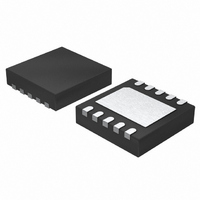LTC3548EDD#TRPBF Linear Technology, LTC3548EDD#TRPBF Datasheet - Page 9

LTC3548EDD#TRPBF
Manufacturer Part Number
LTC3548EDD#TRPBF
Description
IC DC/DC CONV DUAL 10-DFN
Manufacturer
Linear Technology
Type
Step-Down (Buck)r
Datasheet
1.LTC3548EDDPBF.pdf
(16 pages)
Specifications of LTC3548EDD#TRPBF
Internal Switch(s)
Yes
Synchronous Rectifier
Yes
Number Of Outputs
2
Voltage - Output
0.6 ~ 5 V
Current - Output
400mA, 800mA
Frequency - Switching
2.25MHz
Voltage - Input
2.5 ~ 5.5 V
Operating Temperature
-40°C ~ 85°C
Mounting Type
Surface Mount
Package / Case
10-DFN
Lead Free Status / RoHS Status
Lead free / RoHS Compliant
Power - Output
-
Available stocks
Company
Part Number
Manufacturer
Quantity
Price
APPLICATIONS INFORMATION
tantalum capacitors are all available in surface mount
packages. The OS-CON semiconductor dielectric capacitor
available from Sanyo has the lowest ESR (size) product
of any aluminum electrolytic at a somewhat higher price.
Special polymer capacitors, such as Sanyo POSCAP ,
Panasonic Special Polymer (SP), and Kemet A700, of-
fer very low ESR, but have a lower capacitance density
than other types. Tantalum capacitors have the highest
capacitance density, but they have a larger ESR and it
is critical that the capacitors are surge tested for use in
switching power supplies. An excellent choice is the AVX
TPS series of surface mount tantalums, available in case
heights ranging from 2mm to 4mm. Aluminum electrolytic
capacitors have a signifi cantly larger ESR, and are often
used in extremely cost-sensitive applications provided that
consideration is given to ripple current ratings and long
term reliability. Ceramic capacitors have the lowest ESR
and cost, but also have the lowest capacitance density,
a high voltage and temperature coeffi cient, and exhibit
audible piezoelectric effects. In addition, the high Q of
ceramic capacitors along with trace inductance can lead
to signifi cant ringing.
In most cases, 0.1μF to 1μF of ceramic capacitors should
also be placed close to the LTC3548 in parallel with the
main capacitors for high frequency decoupling.
Ceramic Input and Output Capacitors
Higher value, lower cost ceramic capacitors are now be-
coming available in smaller case sizes. These are tempting
for switching regulator use because of their very low ESR.
Unfortunately, the ESR is so low that it can cause loop
stability problems. Solid tantalum capacitor ESR generates
a loop “zero” at 5kHz to 50kHz that is instrumental in giving
acceptable loop phase margin. Ceramic capacitors remain
capacitive to beyond 300kHz and usually resonate with their
V
OUT2
V
IN
TO 5.5V
= 2.5V
C
OUT2
Figure 2. LTC3548 General Schematic
L2
C5
R4
C
IN
BM*
R3
PS*
*MODE/SYNC = 0V: PULSE SKIP
MODE/SYNC = V
MODE/SYNC
SW2
V
RUN2
FB2
LTC3548
GND
V
IN
IN
: Burst Mode
RUN1
SW1
POR
V
FB1
R5
R1
C4
L1
R2
POWER-ON
RESET
C
V
3548 F02
OUT1
OUT1
ESL before ESR becomes effective. Also, ceramic caps are
prone to temperature effects which requires the designer
to check loop stability over the operating temperature
range. To minimize their large temperature and voltage
coeffi cients, only X5R or X7R ceramic capacitors should
be used. A good selection of ceramic capacitors is available
from Taiyo Yuden, AVX, Kemet, TDK and Murata.
Great care must be taken when using only ceramic input
and output capacitors. When a ceramic capacitor is used
at the input and the power is being supplied through long
wires, such as from a wall adapter, a load step at the output
can induce ringing at the V
couple to the output and be mistaken as loop instability.
At worst, the ringing at the input can be large enough to
damage the part.
Since the ESR of a ceramic capacitor is so low, the input
and output capacitor must instead fulfi ll a charge storage
requirement. During a load step, the output capacitor must
instantaneously supply the current to support the load
until the feedback loop raises the switch current enough
to support the load. The time required for the feedback
loop to respond is dependent on the compensation and the
output capacitor size. Typically, 3 to 4 cycles are required to
respond to a load step, but only in the fi rst cycle does the
output drop linearly. The output droop,
about 2 to 3 times the linear drop of the fi rst cycle. Thus,
a good place to start is with the output capacitor size of
approximately: More capacitance may be required depend-
ing on the duty cycle and load step requirements.
In most applications, the input capacitor is merely required
to supply high frequency bypassing, since the impedance
to the supply is very low. A 10μF ceramic capacitor is
usually enough for these conditions.
Setting the Output Voltage
The LTC3548 develops a 0.6V reference voltage between
the feedback pin, V
Figure 2. The output voltage is set by a resistive divider
according to the following formula:
Keeping the current small (<5μA) in these resistors maxi-
mizes effi ciency, but making them too small may allow
V
OUT
= 0.6V 1+
⎛
⎝ ⎜
FB
R2
R1
, and the ground as shown in
⎞
⎠ ⎟
IN
pin. At best, this ringing can
VDROOP
LTC3548
, is usually
3548fc
9














